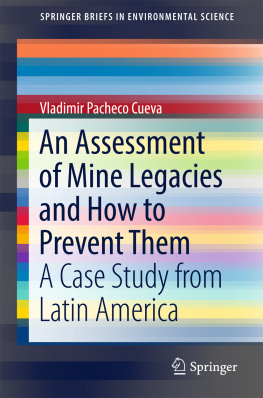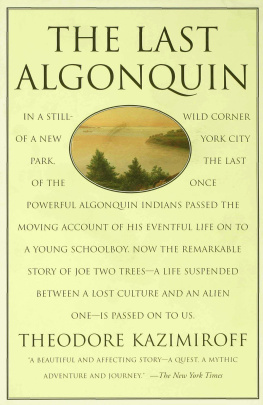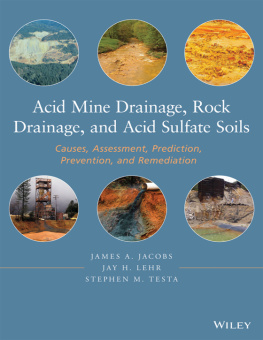The Author(s) 2017 Vladimir Pacheco Cueva An Assessment of Mine Legacies and How to Prevent Them SpringerBriefs in Environmental Science 10.1007/978-3-319-53976-8_1 1. Methodology Vladimir Pacheco Cueva 1 (1) Department of Culture and Society, Aarhus University, Aarhus, Denmark Vladimir Pacheco Cueva Email: Keywords Rapid Rural Appraisal Participatory Rural Appraisal CARITAS Iterative inquiry process Interdisciplinary approach CEICOM 1.1 Research Technique Given the foci of the research, the process of enquiry in this book is iterative or moving from the general to the specific and vice versa. Sometimes national and international trends and statistics are reflected and/or validated in local realities. At other times the reverse occurs: a local observation requires larger trends and explanations in order to make sense. The most appropriate technique for this iterative process is the Rapid Rural Appraisal (RRA). There are many reasons for using this technique in assessing mining legacies: Versatility. Even though RRAs were originally used for rural farm and agricultural projects, these studies have proven to be very versatile and researchers have also used them for all kinds of rural development projects including, but not limited to, health, nutrition, emergencies and disasters, non-formal education, agroforestry and community improvement. Cost effectiveness. RRAs are carried out quickly and with minimal human resources but make use of a mixture of quantitative and qualitative methodologies without significantly affecting the reliability of the study (Teddlie and Tashakkori ). A total of 60 days spread over a period of 15 months were employed in this study and included two 10 day field trips to El Salvador (with a 3 day stay in San Sebastian) in October 2014 and January 2016 and 2 subsequent site visits by a local research assistant. Throughout the study the author maintained remote contact with some of the key informants in San Sebastian in order to corroborate information that emerged after the visit. Reduced urban and expert bias. Chambers refers to RRAs as fairly-quick and-fairly-clean studies, as opposed to quick-and-dirty and long-and-dirty studies in Crawford (). Therefore, in order to keep the results of research fairly quick and clean and minimize urban and expert bias the study was carried out both in situ and remotely and includes the participation of key informants such as the inhabitants of the affected areas, government officials and local NGOs working in areas of community development, water and public health. In order to triangulate the information provided by key informants the research makes reference to statistical data from government ministries, the Central Bank, NGOs and previous studies on subjects such as environmental pollution, mining, human development and water consumption. The research also takes into account relevant national and international academic literature on the subject of mine legacies in both English and Spanish.
1.2 Data Collection Relying on various sources of information means that RRAs can generate large amounts of data within a short period of time. This also means that, often, it can become difficult to separate the ways in which data were collected. Still, three forms of data collection and calculation methods are distinguishable in this study: in situ or field observations; key informant interviews; and analysis of secondary sources. The in situ or field observations are qualitative in nature as well as the interviews with key informants. Secondary sources consisted mostly of quantitative data obtained from government agencies, other studies carried out in the area (such as those by the Centro de Investigacin sobre Inversin y Comercio-CEICOM) and expert opinion. Quantitative data from secondary sources was supplemented with queries to government agencies and local NGOs. The study also made use of results from a CARITAS Participatory Rural Appraisal (PRA) carried out earlier in 2008 at La Presa hamlet, San Sebastian. Additional information about the socio-economic environment of the municipality of Santa Rosa de Lima and the department of La Union came from a variety of sources, including the governments statistical agency (DIGESTYC), the central governments water authority (ANDA), the Ministry of Health and the Central Bank. Also, on several occasions under the auspices of the new law on information access for citizens, the author made use of the Office of Information and Response (OIR) at the Ministry of Economy (Directorate of Hydrocarbons and Mines) and the Ministry of Finance. Interviews were also carried out with officials from the Ministry of Environment and Natural Resources, the Ministry of Agriculture and Livestock and the Hospital in Santa Rosa de Lima. The in situ inspection, interviews with key informants and analysis of secondary sources provided information to suggest that there are four main legacies left by the San Sebastian mine: The AMD legacy impacting surface and ground water. The socio-economic impacts of AMD. The land tenure legacy. The growth of artisanal and small scale mining (ASGM) legacy.
For reasons of space and simplicity the methodology used for each one of these legacies is explained in Chap.. References Crawford IM (1997) Marketing research and information systems (Marketing and Agribusiness Texts4). Food and Agriculture Organization, Rome Teddlie C, Tashakkori A (2003) Major issues and controversies in the use of mixed methods in the social and behavioral sciences. In: Tashakkori A, Teddlie C (eds) Handbook of mixed methods in social and behavioral research. Sage, Thousand Oaks Footnotes The research relied on the cooperation of two local NGOs: ASPRODE and CRIPDES. These NGOs and the communities of San Sebastian have a long history of collaboration meaning that institutional knowledge of the area is strong. Furthermore the author hails from the eastern part of the country and his family has intimate knowledge of the territory where the mine is located. The Author(s) 2017 Vladimir Pacheco Cueva An Assessment of Mine Legacies and How to Prevent Them SpringerBriefs in Environmental Science 10.1007/978-3-319-53976-8_2 2. Knowledge About Mine Legacies, International Best Practice Standards and Mine Closure Regulation in the USA and El Salvador Vladimir Pacheco Cueva 1 (1) Department of Culture and Society, Aarhus University, Aarhus, Denmark Vladimir Pacheco Cueva Email: Keywords Mine legacies El Salvador mining law Berlin guidelines CAMMA ASGMI OCMAL Equator Principles EITI International Cyanide Management Code Minamata Convention Conflict-Free Sourcing Initiative 2.1 What We Know About Mine Legacies Increasing awareness of the long-term negative impacts of mining amongst civil society and academic actors, industry groups and governments has spurred a number of publications, projects and events that seek to define, classify, analyze, assess and document negative mine legacies. Table provides a selection of these activities. Table 2.1 International activities in relation to mine legacies and closure since 1995 Year | Author/organiser | Type | Description | Focus |
|---|
|
|









